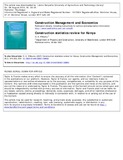| dc.contributor.author | K'akumu, OA | |
| dc.date.accessioned | 2013-08-06T12:05:19Z | |
| dc.date.available | 2013-08-06T12:05:19Z | |
| dc.date.issued | 2007 | |
| dc.identifier.citation | Construction Management and Economics, 25(3): 315-326. | en |
| dc.identifier.uri | http://www.tandfonline.com/doi/abs/10.1080/01446190601139883#.UgFx2W2GPYY | |
| dc.identifier.uri | http://erepository.uonbi.ac.ke:8080/xmlui/handle/123456789/54869 | |
| dc.description.abstract | Construction is a strategic industry in developing economies like Kenya. In order for construction to ably perform this role, there is a need to provide information on its various economic aspects including raw materials, products, processes, finance and labour. Construction statistics of Kenya have been evaluated in order to ascertain their adequacy in terms of scope, portrait, reliability and responsiveness in their coverage of the construction industry. Official statistics published in the annual Statistical Abstract were reviewed according to these adequacy criteria. The findings are that: the scope of construction statistics is narrowly defined making the statistical portrait of the sector incomplete; the statistics are also unreliable in terms of quality and unresponsive to economical challenges of inflation, structural adjustment policies and the decline of the public sector's role in the construction industry. A participatory statistical governance framework is recommended in order to improve the scope of statistics and alleviate the attendant problems, such as the incomplete portrait, that come with the narrow scope. | en |
| dc.title | Construction statistics review for Kenya. | en |
| dc.type | Article | en |
| local.publisher | Urban and regional planning, University of Nairobi | en |

